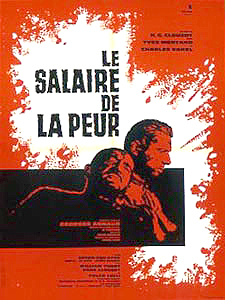Henri-Georges Clouzot, Part II
 With the plethora (yes, plethora) of films available on DVD and Blu-ray, film fans may wonder why bother catching a classic film in a theatre when it’s easily obtainable on home video?
With the plethora (yes, plethora) of films available on DVD and Blu-ray, film fans may wonder why bother catching a classic film in a theatre when it’s easily obtainable on home video?
I’ve actually made a point of ‘testing’ certain favourite films I’ve grown up wit on the big screen at the TIFF Bell Lightbox, and even with a large home theatre setting, there are films that ought to be experienced Big, Loud, and with an audience – of which Jaws (1975) is the best example of a film that’s doubly fun outside of home.
I’ve just uploaded a film review of Henri-Georges Clouzot’s Wages of Fear [M] (1953), which I saw decades ago on TVO in a grainy 16mm print with burnt-in subtitles that flickered and often disappeared when the contrast level was blown out by the video’s inability to handle high white levels.
The film was eventually restored to its original French running time of 148 mins. by Criterion, and the label made a point of striking a new 35mm print with clean subtitles after their recent HD cleanup for home video. Both the DVD and Blu-ray contain various extras (which I’ll review at a future date), and it’s unsurprising some fans will rent or buy the Criterion discs to get extra background on the film and its director; if a film moves you, you want to devour whatever’s out there to reinforce why Wages is one of the best films ever made.
The difference between the DVD and a theatrical screening of Wages amounts to having the dilemma of the four men transporting nitroglycerine by truck magnified to the height and breadth of a small downtown office building (the ones that used to populate Toronto, and are either now conversion lofts, or overpriced condos). The dusty town where Yves Montand eats, sleeps, and makes love is now almost full-sized, and when the deadly journey begins, so starts one of the tensest journeys ever put on film, and the beginnings of a modern suspense drama on wheels.
The most remarkable aspect of Clouzot’s film is the contemporaneousness of his filmmaking technique: both in editing, plot structure, and character conflicts, Wages never veers into melodrama, and its pacing is brazenly bold: running over two hours, it takes 40 minutes before the oil derrick explodes, and another 25 minutes before the first truck leaves town with the deadly nitro, and yet it’s never dull. The pacing and structure recalls the calculated and measured dramas of the seventies, and yet Wages is almost 60 years old.
There is virtually no original score, and the last hour is nearly music free, with Clouzot using nothing but the sounds of the actors and environment, and the two massive trucks which themselves are important characters.
Perhaps the best tribute to Clouzot’s skill happened when the world’s deadliest three-point turn occurred. No music, just a dangerous circumstance that gets worse, and the audience last night was locked into the drama as a buffed Yves Montand (in his first starring role) navigates his truck onto an extension made of rotting wood. It’s a nail-biting sequence that still clicks with audiences in spite of being accustomed to overworked action scenes, and it’s no surprise William Friedkin barely changed the editing style and shot list when he recreated the sequence in his underrated 1977 remake, Sorcerer.
Wages is also remarkable for what Clouzot managed to get away with: generally unsubtle jabs at corporate American imperialism in Third World nations when oil was touted by the industry as the latest gateway potion to a modern society.
Wages of Fear screens Fri. Oct. 21, Sun. Oct. 23, and Mon. Oct. 24th at the Lightbox as part of their current Clouzot retrospective, which now overlaps a current tribute to Nicholas Ray.
Titled Hollywood Classics: The Cinema Is Nicholas Ray, the series includes a number of films unavailable on home video, plus two very special films: We Can’t Go Home Again, the experimental feature Ray was working on between 1973-1979, and Don’t Expect Too Much (2011), a making-of doc by the director’s widow, Susan Ray, who will also provide introductions to the screenings of We Can’t Go Home Again and Bitter Victory (1957).
Brief bits of We Can’t Go Home Again were glimpsed in Wim Wenders’ Lightning Over Water (1980), a dreadfully problematic documentary filmed as the director was dying onscreen, but the upcoming Oct. 30th screening marks a rare occasion when Ray’s legendary mixed media work will be shown in public.
I’ll have reviews of the film and the making-of doc, and already have my eye on 55 Days at Peking, the 1962 epic from which Ray was dumped by producer Samuel Bronston (El Cid, Fall of the Roman Empire), and never directed another full-length feature for a Hollywood studio.
Coming shortly: soundtrack reviews, plus Nightmare on Elm Street 3: Dream Warriors (1987). Yes, I can and will go from Clouzot to Chuck Russell. So there.
.
.
Mark R. Hasan, Editor
KQEK.com ( Main Site / Mobile Site )
Category: EDITOR'S BLOG, FILM REVIEWS

















Connect